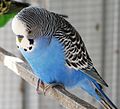
The science of budgerigar color genetics deals with the heredity of mutations which cause color variation in the feathers of the species known scientifically as Melopsittacus undulatus. Birds of this species are commonly known by the terms 'budgerigar', or informally just 'budgie'.
The Recessive Pied budgerigar mutation is one of approximately 30 mutations affecting the colour of budgerigars. It is the underlying mutation of the Danish Pied variety, aka Harlequin. It is believed by Inte Onsman of MUTAVI to be the same mutation as the Anti-dimorphic Pied found in some parrots. The Dark-eyed Clear variety results when the Recessive Pied and Clearflight Pied characters are combined.
The Blue budgerigar mutation is one of approximately 30 mutations affecting the colour of budgerigars. It is part of the genetic constitution of the following recognised varieties: Skyblue, Cobalt, Mauve and Violet.
The Yellowface I budgerigar mutation is one of approximately 30 mutations affecting the colour of budgerigars.
The Yellowface II budgerigar mutation is one of approximately 30 mutations affecting the colour of budgerigars. In combination with the Blue, Opaline and Clearwing mutations, the single factor Yellowface II mutation produces the variety called Rainbow.
The Dominant Grey budgerigar mutation, often called the Australian Grey or simply Grey, is one of approximately 30 mutations affecting the colour of budgerigars. It is the basis of the Grey-Green and Grey standard varieties.
The violet budgerigar mutation is one of approximately 30 mutations affecting the colour of budgerigars. It is one of the constituent mutations of the violet variety.
The Dilute budgerigar mutation is one of approximately 30 mutations affecting the colour of budgerigars. It is one of the constituent mutations of several recognised varieties: the Light, Dark, Olive, Grey and Suffused Yellows and the Grey and Suffused Whites.
The Clearwing budgerigar mutation is one of approximately 30 mutations affecting the colour of budgerigars. It is the underlying mutation of the Clearwing variety, often known as Yellowwings in the green series and Whitewings in the blue series. When combined with the Greywing mutation the variety is known as the Full-bodied Greywing. When combined with the Yellowface II and Opaline mutations the Rainbow variety is produced.
The Greywing budgerigar mutation is one of approximately 30 mutations affecting the colour of budgerigars. It is the underlying mutation of the Greywing variety. When combined with the Clearwing mutation the variety is known as a Full-bodied Greywing.
The Opaline budgerigar mutation is one of approximately 30 mutations affecting the colour or appearance of budgerigars. It is the underlying mutation of the Opaline variety. When combined with the Yellowface II and Clearwing mutations the Rainbow variety is produced.
The Cinnamon budgerigar mutation is one of approximately 30 mutations affecting the colour of budgerigars. It is the underlying mutation of the Cinnamon variety and, with Ino, a constituent mutation of the Lacewing variety.
The Ino budgerigar mutation is one of approximately 30 mutations affecting the colour of budgerigars. It is the underlying mutation of the Albino and Lutino varieties and, with Cinnamon, a constituent mutation of the Lacewing variety.

The Slate budgerigar mutation is one of approximately 30 mutations affecting the colour of budgerigars. It is the underlying mutation of the Slate variety.
The Dominant Clearbody budgerigar mutation is one of approximately 30 mutations affecting the colour of budgerigars. It is the underlying mutation of the Easley Clearbody variety.
The German Fallow budgerigar mutation is one of approximately 30 mutations affecting the colour of budgerigars. At least three types of Fallow, the German, English, and Scottish, all named after their country of origin, have been established, although none of these types is common. They are superficially similar, but adult birds may be distinguished by examining the eye. All have red eyes, but the German Fallow shows the usual white iris ring, the eye of the English Fallow is a solid red with a barely discernible iris and the iris of the Scottish Fallow is pink.
The English Fallow budgerigar mutation is one of approximately 30 mutations affecting the colour of budgerigars. At least three types of Fallow, the German, English and Scottish, all named after their country of origin, have been established, although none of these types is common. They are superficially similar, but adult birds may be distinguished by examining the eye. All have red eyes, but the German Fallow shows the usual white iris ring, the eye of the English Fallow is a solid red with a barely discernible iris and the iris of the Scottish Fallow is pink.
The Scottish Fallow budgerigar mutation is one of approximately 30 mutations affecting the colour of budgerigars. At least three types of Fallow, the German, English and Scottish, all named after their country of origin, have been established, although none of these types is common. They are superficially similar, but adult birds may be distinguished by examining the eye. All have red eyes, but the German Fallow shows the usual white iris ring, the eye of the English Fallow is a solid red with a barely discernible iris and the iris of the Scottish Fallow is pink.
The English Grey budgerigar mutation is one of approximately 30 mutations affecting the colour of budgerigars. It appeared briefly in the 1930s but was lost shortly after and until recently was believed to be no longer extant. However, the appearance of the anthracite budgerigar mutation in 1998 with a seemingly identical appearance and identical genetic behaviour, insofar as can now be determined, suggests the mutation may have been regained.
The Anthracite budgerigar mutation is an extremely rare mutation that occurs in the budgerigar. The mutation, similar to the Violet budgerigar mutation, causes a difference in the coloring of budgerigars. Anthracites have black or very dark gray feathers, possibly with some white depending on the budgerigar in particular. The mutation is believed to have started in Germany, and tends to be local to that area. Currently, most owners wishing to obtain an Anthracite need to import these budgerigars from Germany.







